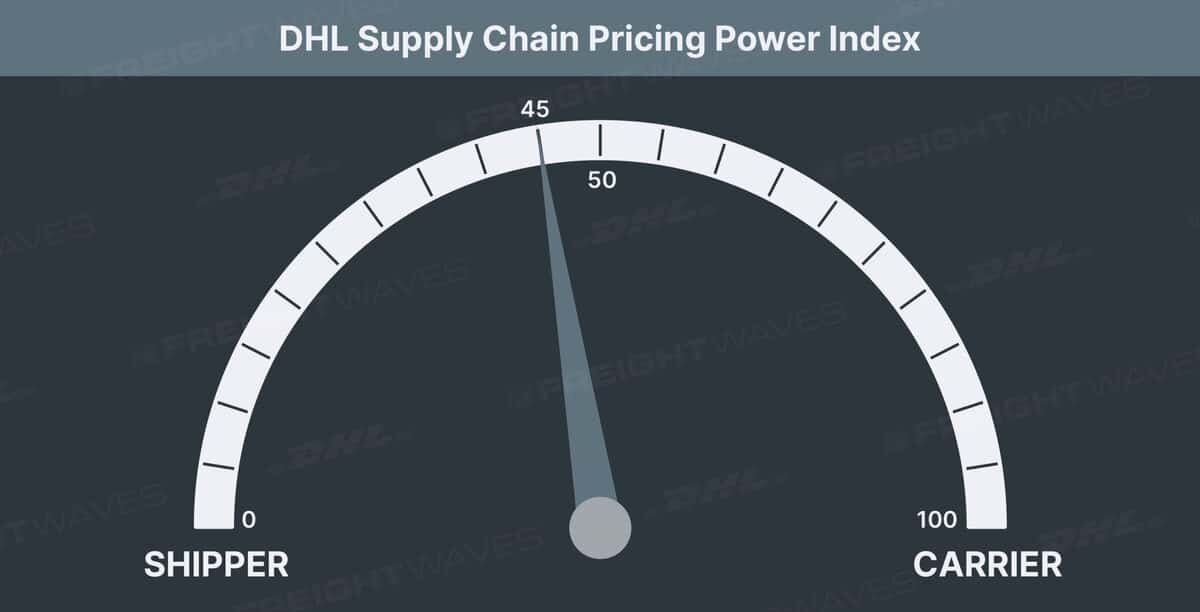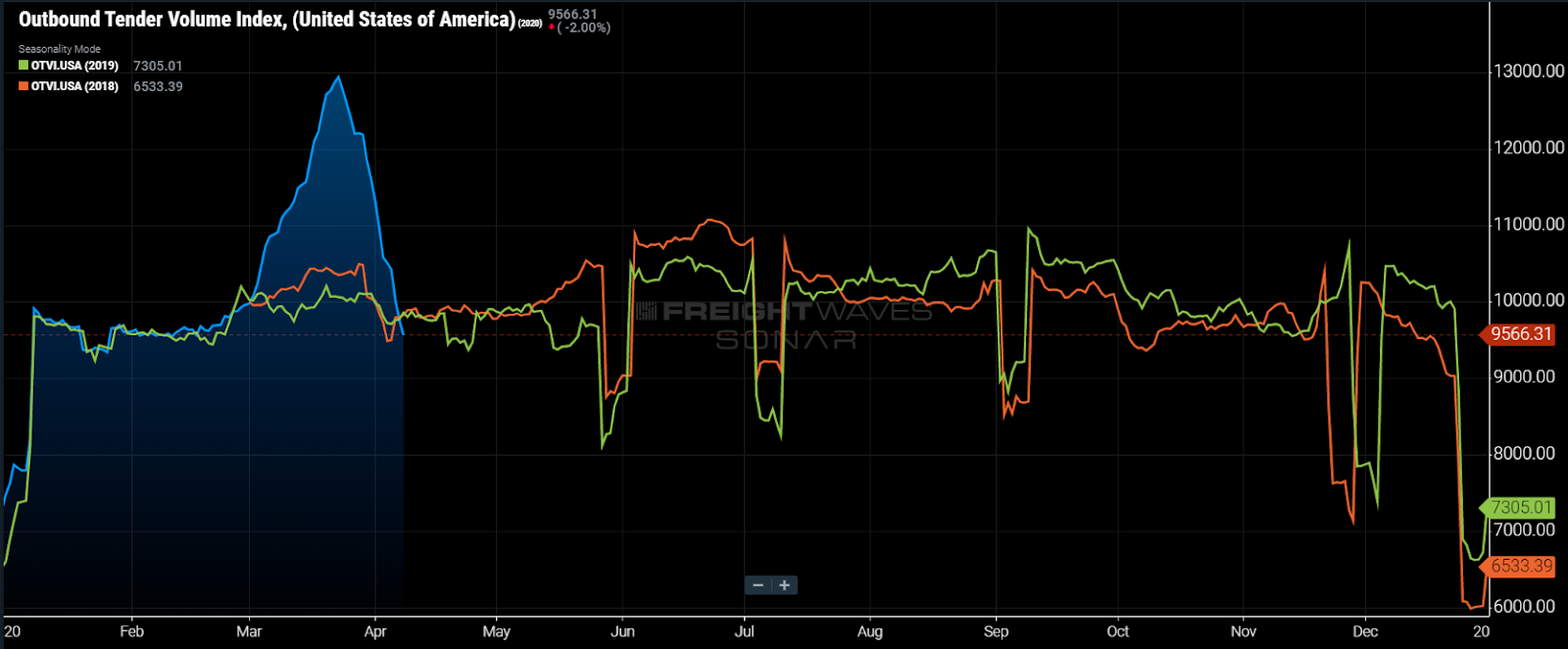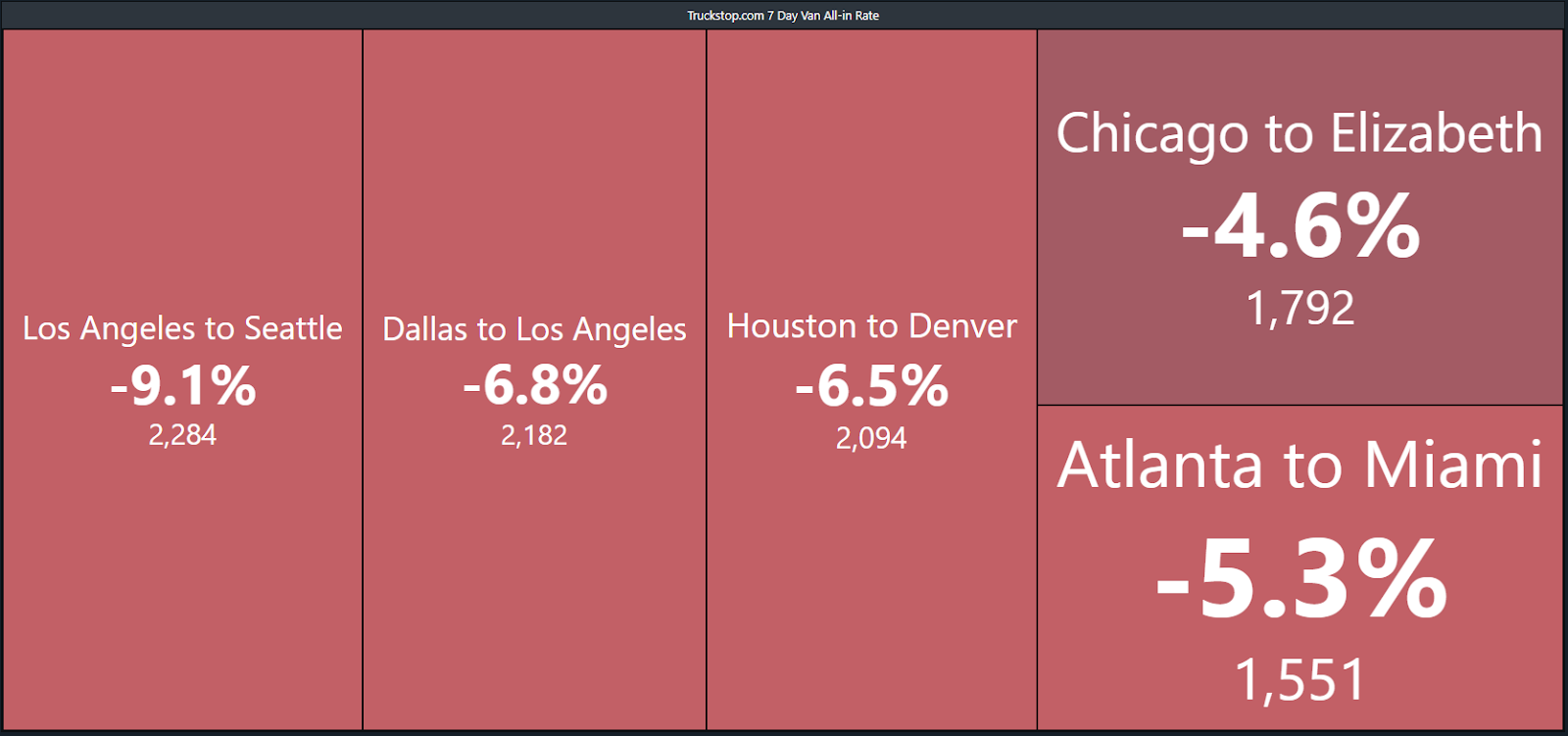As quickly as freight carriers gained an edge in pricing power, the pendulum has just as quickly swung back to the shippers, according to the latest DHL Supply Chain Pricing Power Index.
After reaching a reading of 65 two weeks ago, it fell to a reading of 60 last week and this week has plummeted to 45.
The DHL Supply Chain Pricing Power Index uses the analytics and data contained in FreightWaves SONAR to analyze the market and estimate the negotiating power for rates between shippers and carriers. A reading above 50 indicates carriers have leverage in pricing power, while readings below 50 give the advantage to shippers.

National freight volumes are now below what we would expect in normal times, and capacity has now loosened to pre-crisis levels, the data shows. Spot rates are plummeting in kind, with only five of the 100 Truckstop.com spot rate lanes showing positive weekly growth. There is no end in sight to the volume decline – America is still under quarantine and more businesses shut down with every passing day.
Load volumes: Absolute levels and momentum neutral
National outbound freight volumes have gone faster than they came. The coronavirus giveth a freight frenzy, and the coronavirus taketh said frenzy. The Outbound Tender Volume Index (SONAR: OTVI.USA) is now below where we would expect it to be during “normal times.” The index is below its March 2018 starting point of 10,000, currently sitting at 9,566.31. Since the peak of the freight frenzy 16 days ago, OTVI has fallen 26%. It took 31 days for national freight volumes to rise from normal levels to their peak on March 24.

National truckload freight volumes are now at the same point they were on Feb. 17. There is no end to the volume deceleration in sight. At the time of writing, 94% of Americans are still under shelter-in-place orders. Even if consumers weren’t under orders to stay home, the businesses in their communities are still shut down. The U.S. Chamber of Commerce released a survey of small businesses that stated within two weeks more than 50% of small businesses would be completely shut down. Small businesses move a significant amount of truckload freight. National freight volumes will continue to underperform as long as small businesses are not open. Carriers need to prepare for a time when trucks are sitting idle.

Tender rejections: Absolute levels and momentum positive for shippers
Much like OTVI, the Outbound Tender Rejection Index (SONAR: OTRI.USA) has also fallen back to “normal levels.” In the 11 days since peak tender rejections, OTRI has fallen 60% – from 19.25% to 7.64%. Just as with volumes, capacity is loosening faster than it tightened. In the 11 days prior to peak OTRI, the index increased 43%. This was a drastic but short-lived tightening of capacity. Due to the steep decline in volumes, capacity has now returned to what we would expect in a normal spring environment.
Capacity will continue to loosen as freight dries up throughout April. With a vast majority of the country on lockdown and many industries at near cancellation, there simply isn’t enough freight to keep capacity tight.

Spot rates: Absolute levels and momentum positive for shippers
Spot rates are quickly adjusting downward due to the changing supply-demand dynamics. Volumes are plummeting with no floor in sight, and capacity is loosening in kind. Of the 100 lanes Truckstop.com provides spot rate data for in SONAR, only five have positive weekly spot rate growth. Spot rates have peaked for this mini-cycle and, much like volumes, have no floor in sight.
We believe rates will quickly encroach upon operational costs per mile during April. There will be expectations for grocery, consumer staples and medical supplies, but overall rates will be down considerably on a yearly and sequential basis in April.

Economic stats: Momentum and absolute level positive for shippers
Backward-looking economic data is relatively useless at this point. Nonetheless, several economic data releases this past week are worth examining.
By far the most widely watched blockbuster economic data point this week was initial jobless claims, which came out today. Given its frequency, this is one of the best real-time indicators we have.
We just received the jobless claims for the first week of April and they were 6.6 million; this comes on the heels of 6.9 million initial jobless claims last week and 3.3 million the week before last. To put into context just how high that number is, 4% of the American workforce lost their jobs in a single week (for the second week in a row) and the 6.6 million initial claims are about 10 times the peak of 665,000 in the 2008-09 recession and the all-time record of 695,000 in October 1982. If there is any good news at all, initial jobless claims this week fell 291,000 sequentially, which hopefully indicates weekly claims could be peaking. This brings the three-week cumulative job losses to more than 16 million and means that the unofficial unemployment rate now sits at near 14%, nearly five times the 50-year low of 3.5% from just a month ago. The chart of initial claims going back to the 1960s is stunning and an anomaly unlike any that has been seen.
On Thursday, the Federal Reserve disclosed a new $2.3 trillion stimulus package that is quite detailed but includes significantly more assistance to households, governments and businesses.
Regarding the importance of the government’s Payroll Protection Program (PPP), in a special report on small business from the U.S. Chamber of Commerce this week, nearly one in four small businesses (24%) say they are at risk of permanently closing if the shutdown continues for two more months. More than one in 10 (11%) small businesses note that they will not be able to last one month of shutdowns. And finally, 43% say they have less than six months before they will have to permanently close. Nearly one-quarter (24%) of small businesses are already temporarily shut down due to COVID-19, while another 40% report it is likely that they will do so in the next two weeks. This means that a total of 54% of small businesses will be temporarily closed and not moving freight within two weeks. The implications for freight are dramatic – small businesses move a large percentage of overall freight in the U.S..
Bank of America (BOA), the first major lending institution to ramp up the PPP loan assistance program from the U.S. Small Business Association (SBA) as part of the stimulus package, said on April 6 that it has seen overwhelming demand for loans out of the gate (the program launched on Friday, April 3). Applications for rescue loans received by BOA already account for nearly 10% of the total $350 billion allotment from Congress. BOA has received 177,000 applications from small businesses for a total of $32.6 billion in potential financing (the amount does not represent approved loans). These figures have undoubtedly risen dramatically in the last three days across all participating lending institutions.
Small businesses are rushing to get access to rescue funding before they go out of business and out of fear of missing out on part of the $350 billion allocation. However, Treasury Secretary Steve Mnuchin has noted that the program will be increased if demand exceeds $350 billion. We believe the program will indeed be increased in the coming weeks. For the freight markets to make a quick recovery (we expect a continued sharp dropoff in short order), getting rescue loans out to small businesses quickly and efficiently is paramount.
For more information on the FreightWaves Freight Intel Group, please contact Kevin Hill at khill@freightwaves.com, Seth Holm at sholm@freightwaves.com or Andrew Cox at acox@freightwaves.com.










